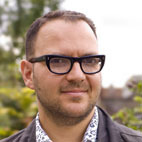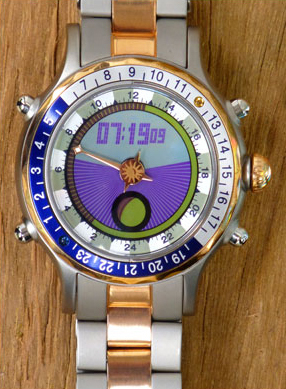Stewart Brand's Blog, page 87
June 25, 2012
Voyager 1 Heads Into Uncharted Territory
Scientists at NASA have announced that Voyager 1 is making its way through the very outer edges of our solar system. Sooner than expected, they say, the space probe will leave our tiny corner of the Milky Way behind, and become the first man-made craft to enter the dark reaches of interstellar space.
Voyager 1 was launched in 1977 to explore the dominions of Jupiter and Saturn, and has been at the forefront of space exploration ever since. In the 1980s, it sent us unprecedented close-up images of these two gas giants and their moons, facilitating new discoveries about their history and makeup. From there, Voyager headed deeper into the recesses of the heliosphere. In 1998, it overtook Pioneer 10 to become the most distant man-made object from the Sun, and fourteen years later it finds itself at a distance of 11.1 billion miles from Earth, in a region of the solar system where solar winds slow down considerably – enough to let in certain cosmic ray particles that are usually deflected by these winds. This outer edge is called the heliosheath; a region so far away that the data Voyager 1 sends back to Earth take 16 hours and 38 minutes to reach us.
It’s an increase in the detection of those cosmic ray particles that now tells scientists that Voyager 1 is getting close to the heliopause – the outer boundary of our solar system. They predict it might not be until 02014 that Voyager truly leaves the solar system once and for all. The heliosheath could be hundreds of thousands of miles thick, and Voyager’s exit from the solar system will thus be more of a gradual process of transition, than a demarcated event. The Atlantic Monthly, reporting on this news from NASA, writes:
So perhaps Voyager won’t make its mark with a sudden, defining event that echoes across generations as a sort of before-and-after dividing line across human history, like the line separating the time when a human’s voice had never traveled across a wire to an ear miles away – and when it had – or before a human foot had left its imprint on the moon, and when that print was there. But Stone is okay with that: “Well you know actually Voyager has had a lot of those moments as we flew by Jupiter, Saturn, Uranus, and Neptune. One after the other, we found something that we hadn’t realized was there to be discovered.
But, the Atlantic admits, “it’s hard not to sit on the edge of your seat to wait for this moment – this months-long moment – to pass.” Gradual as it may be, it is a momentous event nonetheless. Not just because Voyager 1 is carrying us into a new age of space exploration, but also because it is doing so as a 35-year old mission, whose technology NASA has had no way of updating since its launch in the late ‘70s. The fact that NASA’s engineers and scientists were able to design a machine that would be able to communicate with Earth across decades worth of time and space – and that would be able to measure phenomena that had never been measured before – is in and of itself momentous enough to contemplate.

June 22, 2012
Tour of Asia in 90 Seconds
Long Now Board Member Kevin Kelly recently went on a two-month voyage through Asia. But don’t worry – he won’t make you sit through hours of travel pictures. Instead, he’s made a video that condenses his 60-day trip into a mere 90 seconds:
Kelly took 1 second of footage for each day of his trip (2 seconds on some days) and glued them together into this short burst of color, sound, and movement. The video is an accelerated depiction of life, but also shows just how much life can be packed into a single second. A second can contain a wealth of impressions and sensations – it’s enough for a change of perspective, and enough to learn something new about the world.
As such, the video ultimately has the seeming effect of slowing down time. And of reminding us that the speed of time is relative – two months can pass by in the blink of an eye, and a second can last forever.

June 20, 2012
Endangered Languages Project launches
The Rosetta Project and PanLex Project at The Long Now Foundation are excited to announce that we are participating in a new initiative called the Endangered Languages Project, which is backed by the Alliance for Linguistic Diversity.
As member organization of the Alliance, we will be providing support for the Project, which aims to:
- accelerate, strengthen, and catalyze efforts around endangered language documentation,
- support communities engaged in protecting or revitalizing their languages, and
- raise awareness about ways to address threats to endangered languages.
Through the Endangered Languages Project, endangered language communities and scholars are able to contribute their own materials by uploading language documentation via Google tools such as Google Docs and YouTube. Alliance members will help maintain the project as an open space so that any user can find, share, and discuss the most comprehensive and up to date information and primary data on endangered languages.
As part of our contribution, the PanLex project has offered to make accessible its compilation of a half-billion pairwise translations among 17 million lexemes in 6,000 languages. Our hope is that this data can be made available through the Endangered Languages Project to promote collaboration with researchers and enable more than a trillion additional inferred lexical translations.

June 19, 2012
Cory Doctorow Seminar Tickets
Seminars About Long-term Thinking

Cory Doctorow on “The Coming Century of War Against Your Computer”
TICKETS
Tuesday July 31, 02012 at 7:30pm Novellus Theater at YBCA
Long Now Members can reserve 1 seat, join today! • General Tickets $10
About this Seminar:
The war against computer freedom will just keep escalating, Doctorow contends. The copyright wars, net neutrality, and SOPA (Stop Online Piracy Act) were early samples of what is to come. Victories in those battles were temporary. Conflict in the decades ahead will feature ever higher stakes, more convoluted issues, and far more powerful technology. The debate is about how civilization decides to conduct itself and in whose interests.
“Cory Doctorow is one of the great context-setters of our generation,” says Tim O’Reilly. Co-editor of the acclaimed blog “Boing Boing,” Doctorow writes contemporary science fiction blending contextual insight with journalistic depth. His recent books include For the Win; Makers; and Little Brother.

June 18, 2012
Benjamin Barber Seminar Media
 This lecture was presented as part of The Long Now Foundation’s monthly Seminars About Long-term Thinking.
This lecture was presented as part of The Long Now Foundation’s monthly Seminars About Long-term Thinking.
If Mayors Ruled the World
Tuesday June 5, 02012 – San Francisco
Video is up on the Barber Seminar page for Members.
*********************
Audio is up on the Barber Seminar page, or you can subscribe to our podcast.
*********************
City-based global governance – a summary by Stewart Brand
Sovereign nation states have conspicuously failed to cooperate well enough to deal with increasingly global problems such as climate change, environmental degradation, and organized crime, Barber said. Nations focus on their borders, which are seen as competitive zero-sum games. “But if we shift our gaze, in thinking about global governance, from nation states to cities, things suddenly become possible that seemed impossible. Cities are apart from one another, separated by wide spaces. Their relationships are based on communication, trade, transportation, and culture. They are relational, not in a zero-sum game with one another.”
Cities are inherently pragmatic rather than ideological. “They collect garbage and collect art rather than collecting votes or collecting allies. They put up buildings and run buses rather than putting up flags and running political parties. They secure the flow of water rather than the flow of arms. They foster education and culture in place of national defense and patriotism. They promote collaboration, not exceptionalism.”
An honoring of all that practicality is shown by polling results of confidence in various levels of government. Only 18 percent of Americans have confidence in the US Congress (“the lowest in a long time”). The Presidency gets 44 percent. Americans have 65 percent confidence in their mayors. They can see clearly that city governments are less distorted by party politics, less responsive to massive lobbying. They see mayors getting things done.
New York City’s “hyperactive” mayor Michael Bloomberg says, “I don’t listen to Washington very much. The difference between my level of government and other levels of government is that action takes place at the city level. While national government at this time is just unable to do anything, the mayors of this country have to deal with the real world.” After 9/11, New York’s police chief sent his best people to Homeland Security to learn about dealing with terrorism threats. After 18 months they reported, “We’re learning nothing in Washington.” They were sent then to twelve other cities—Singapore, Hong Kong, Paris, Frankfurt, Rio—and built their own highly effective intelligence network city to city, not through Washington or Interpol.
Last year following the meeting in Mexico City on climate, where little progress was made by the national delegations, representatives from 207 cities signed a Global Cities Climate Pact pledging to pursue “strategies and actions aimed at reducing greenhouse gas emissions.” The cities did what the nations could not. There are many existing bodies of robust cooperation among cities—the International Union of Local Authorities, the World Association of Major Metropolises, the American League of Cities, the Local Governments for Sustainability, the C40 Cities Climate Leadership Group, the United Cities and Local Governments at the UN, the New Hanseatic League, the Megacities Foundation—200 such networking organizations. “They are dull sounding, but they are fashioning global processes that work.”
Global governance needs no great edifice with unitary rulers. It can be voluntary, informal, bottom-up. Barber recommends forming a global parliament of cities, because nation states will not govern globally. Cities can. They already are.
Subscribe to our Seminar email list for updates and summaries.

June 14, 2012
The History of Computers
When we think about the development of computers, we often think into the future: we imagine (or work on developing) new software, ever larger capacities for data storage, and ever smaller, sleeker hardware design.
But Ptak Science Books, a blog on the history of science with an emphasis on images, gives us an interesting look back at the products and designs that got us to where we are today. This page offers a chronological list of computers made between 1938 and 1988 (notice that more computers were made in the 1960s than in any of the decades before, as well as after!). And for those of you who are interested to know exactly how the ENIAC begat the UNIVAC, and how these two behemoths are related to IBM, take a look at the expandable family tree – a naturalistic visualization of how these dinosaurs of the computer age evolved from one another.

June 7, 2012
Benjamin Barber Seminar Media
 This lecture was presented as part of The Long Now Foundation’s monthly Seminars About Long-term Thinking.
This lecture was presented as part of The Long Now Foundation’s monthly Seminars About Long-term Thinking.
If Mayors Ruled the World
Tuesday June 5, 02012 – San Francisco
Audio is up on the Barber Seminar page, or you can subscribe to our podcast.
*********************
City-based global governance – a summary by Stewart Brand
Sovereign nation states have conspicuously failed to cooperate well enough to deal with increasingly global problems such as climate change, environmental degradation, and organized crime, Barber said. Nations focus on their borders, which are seen as competitive zero-sum games. “But if we shift our gaze, in thinking about global governance, from nation states to cities, things suddenly become possible that seemed impossible. Cities are apart from one another, separated by wide spaces. Their relationships are based on communication, trade, transportation, and culture. They are relational, not in a zero-sum game with one another.”
Cities are inherently pragmatic rather than ideological. “They collect garbage and collect art rather than collecting votes or collecting allies. They put up buildings and run buses rather than putting up flags and running political parties. They secure the flow of water rather than the flow of arms. They foster education and culture in place of national defense and patriotism. They promote collaboration, not exceptionalism.”
An honoring of all that practicality is shown by polling results of confidence in various levels of government. Only 18 percent of Americans have confidence in the US Congress (“the lowest in a long time”). The Presidency gets 44 percent. Americans have 65 percent confidence in their mayors. They can see clearly that city governments are less distorted by party politics, less responsive to massive lobbying. They see mayors getting things done.
New York City’s “hyperactive” mayor Michael Bloomberg says, “I don’t listen to Washington very much. The difference between my level of government and other levels of government is that action takes place at the city level. While national government at this time is just unable to do anything, the mayors of this country have to deal with the real world.” After 9/11, New York’s police chief sent his best people to Homeland Security to learn about dealing with terrorism threats. After 18 months they reported, “We’re learning nothing in Washington.” They were sent then to twelve other cities—Singapore, Hong Kong, Paris, Frankfurt, Rio—and built their own highly effective intelligence network city to city, not through Washington or Interpol.
Last year following the meeting in Mexico City on climate, where little progress was made by the national delegations, representatives from 207 cities signed a Global Cities Climate Pact pledging to pursue “strategies and actions aimed at reducing greenhouse gas emissions.” The cities did what the nations could not. There are many existing bodies of robust cooperation among cities—the International Union of Local Authorities, the World Association of Major Metropolises, the American League of Cities, the Local Governments for Sustainability, the C40 Cities Climate Leadership Group, the United Cities and Local Governments at the UN, the New Hanseatic League, the Megacities Foundation—200 such networking organizations. “They are dull sounding, but they are fashioning global processes that work.”
Global governance needs no great edifice with unitary rulers. It can be voluntary, informal, bottom-up. Barber recommends forming a global parliament of cities, because nation states will not govern globally. Cities can. They already are.
Subscribe to our Seminar email list for updates and summaries.

June 6, 2012
Susan Freinkel Seminar Media
 This lecture was presented as part of The Long Now Foundation’s monthly Seminars About Long-term Thinking.
This lecture was presented as part of The Long Now Foundation’s monthly Seminars About Long-term Thinking.
Eternal Plastic: A Toxic Love Story
Tuesday May 22, 02012 – San Francisco
Video is up on the Freinkel Seminar page for Members.
*********************
Audio is up on the Freinkel Seminar page, or you can subscribe to our podcast.
*********************
Making Plastic Even Better- a summary by Stewart Brand
Plastic is so new, Freinkel began, that among all the objects preserved in the sunken Titanic, none are synthetic plastic, because there was hardly any available in 1912. Natural plastic, however, was a familiar material. Amber was popular. Rubber was essential (all plant cellulose is made of long-chain polymers). Ivory for everything from billiard balls to piano keys was in such high demand that an 1867 paper warned about the looming extinction of elephants. The first synthetic plastic—celluoid—was developed as a substitute for ivory, and the elephants survived.
Bakelite was invented in 1907 to replace the beetle excretion called shellac (“It took 16,000 beetles six months to make a pound of shellac.”), and was first used to insulate electrical wiring. Soon there were sturdy Bakelite radios, telephones, ashtrays, and a thousand other things. The technology democratized consumption, because mass production made former luxury items cheap and attractive. The 1920s and ‘30s were a golden age of plastic innovation, with companies like Dow Chemical, DuPont, and I. G. Farben creating hundreds of new varieties of plastic for thrilled consumers. Cellophane became a cult. Nylons became a cult. A plastics trade show in 1946 had 87,000 members of the public lining up to view the wonders. New fabrics came along—Orlon and Dacron—as colorful as the deluge of plastic toys—Barbie, the Frisbee, Hula hoops, and Silly Putty.
Looking for new markets, the marketers discovered disposability—disposable cups for drink vending machines, disposable diapers (“Said to be responsible for the baby boom”), Bic lighters, soda bottles, medical syringes, and the infinite market of packaging. Americans consume 300 pounds of plastic a year. The variety of plastics we use are a problem for recycling, because they have to be sorted by hand. They all biodegrade eventually, but at varying rates. New bio-based polymers like “corn plastic” and “plant bottles” have less of a carbon footprint, but they biodegrade poorly. Meanwhile, thanks to the efficiencies of fracking, the price of natural gas feedstock is plummeting, and so is the price of plastic manufacture.
Some plastics have some chemicals like bisphenol A and phthalates that are toxic. American manufacturers don’t have to list the materials in their products, and there’s no hope of testing every one of the 80,000 industrialized chemicals loose in the world. Freinkel recommends greatly expanding the practice of “green chemistry,” so that every process and product of manufacturing is safe and sustainable from the ground up. She would like to see a stronger regulatory environment and the building of a fully systemic recycling infrastructure.
In the Q & A Freinkel recommended a book by Elizabeth Grossman, Chasing Molecules: Poisonous Products, Human Health, and the Promise of Green Chemistry.
Subscribe to our Seminar email list for updates and summaries.

YES Watch Father’s Day Sale

Long Now’s 10,000 Year Clock will tell time not in hours and minutes, but by keeping track of the astronomical cycles underlying those units. We can’t predict how the calendar and timing systems will change over the next 10,000 years, but we know they’re likely to be built on top of the very same things we’ve built our system on: the rotation of the earth, the cycles of the moon, and the ebb and flow of light and dark throughout the years’ seasons. For most of human history, time wasn’t a matter of digits ticking by, but rather a complex interplay of these overlapping rhythms.
The makers of YES watches seem to similarly appreciate this long-view of time-keeping. Into thoroughly modern digital timepieces with all the standard functionality you’d expect in a digital watch, they’ve incorporated a taste of our deep history with the sky. YES watches feature an analogue hour hand that rotates once each day, indicating along its way the rising and setting of the sun and moon.
It’s because of this resonance that we’ve carried them for years now in our Museum & Store in San Francisco, but between now and Father’s Day, Yes is also giving Long Now a 20% commission on each watch bought online through this link: www.yeswatch.com/longnow For Father’s Day, they’ve created a new style of watch with two 24-hour bezels.
Bjorn Kartomten is the brains behind this innovative design. He worked with a global team of manufacturers to realize his idea of making a watch that tells modern time along side the cycles of the sun and moon. The hand movement is made in Switzerland, the sapphire crystal in Germany and the chip is made in Japan. The Yes Watches are used by film directors, photographers, adventurers and more – anyone who would like to to have an accurate understanding of the day and night’s natural cycles.

May 31, 2012
Alexander Rose on The Conversation
Radio producer Aengus Anderson began a project earlier this year with the goal of facilitating a conversation about the paradigms we may have to leave behind if we’re to build the future we want. Over the next several months, he’ll be motorcycling all over the United States and discussing the future with thinkers, do-ers, artists and makers. He posts those recordings on The Conversation and invites listeners to give feedback, offer critique, and to suggest questions for future participants:
The Conversation is a new type of media project. It’s not journalism, documentary, or oral history. Instead, it is an asynchronous conversation about the future between a cross-section of American thinkers and you, our participants on the web. Aengus is going to be traveling America from May to October, posting two audio interviews a week and carrying ideas from one interviewee to the next. As Aengus travels, you will be able to join the conversation online, commenting on specific interviews and suggesting themes and questions for Aengus to pursue in upcoming interviews.
He sat down recently with Long Now’s Alexander Rose to talk about long-term thinking, the 10,000 Year Clock, and generational-scale problem solving. Alexander’s interview is the seventh in the series, with many more to come!

Stewart Brand's Blog
- Stewart Brand's profile
- 291 followers





